Advertisements
Advertisements
प्रश्न
In triangle ABC, AP : PB = 2 : 3. PO is parallel to BC and is extended to Q so that CQ is parallel to BA.
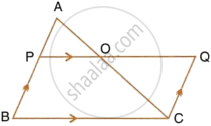
Find:
- area ΔAPO : area ΔABC.
- area ΔAPO : area ΔCQO.
उत्तर
In ΔABC,
AP : PB = 2 : 3
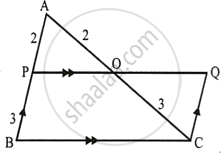
PQ || BC and CQ || BA
∵ PQ || BC
∴ `(AP)/(PB) = (AO)/(OC) = 2/3`
i. In ΔAPQ ∼ ΔABC
∴ `(Area ΔAPO)/(Area ΔABC) = (AP^2)/(AB^2)`
= `(AP^2)/(AP + PB)^2`
= `(2)^2/(2 + 3)^2`
= `4/25`
∴ area ΔAPO : area ΔABC = 4 : 25
ii. In ΔAPO and ΔCQO
∠APO = ∠OQC ...(Alternate angles)
∠AOP = ∠COQ ...(Vertically opposite angles)
∴ ΔAPO ∼ ΔCQO ...(AA axiom)
∴ `(Area ΔAPO)/(Area ΔCQO) = (AP^2)/(CQ^2)`
= `(AP^2)/(PB^2)` {∵ PBCQ is a || gm}
= `(2)^2/(3)^2`
= `4/9`
∴ area ΔAPO : area ΔCQO = 4 : 9
APPEARS IN
संबंधित प्रश्न
Given : AB || DE and BC || EF. Prove that :
- `(AD)/(DG) = (CF)/(FG)`
- ∆DFG ∼ ∆ACG

Through the mid-point M of the side CD of a parallelogram ABCD, the line BM is drawn intersecting diagonal AC in L and AD produced in E. Prove that: EL = 2BL.
In the given figure, P is a point on AB such that AP : PB = 4 : 3. PQ is parallel to AC.
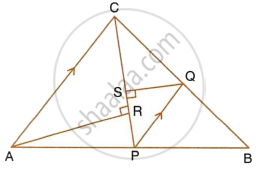
- Calculate the ratio PQ : AC, giving reason for your answer.
- In triangle ARC, ∠ARC = 90° and in triangle PQS, ∠PSQ = 90°. Given QS = 6 cm, calculate the length of AR.
In the right-angled triangle QPR, PM is an altitude.
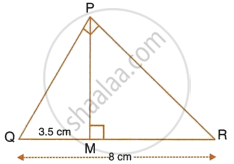
Given that QR = 8 cm and MQ = 3.5 cm, calculate the value of PR.
In the given triangle PQR, LM is parallel to QR and PM : MR = 3 : 4.
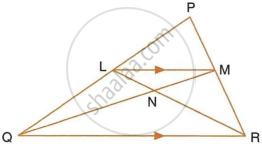
Calculate the value of ratio:
- `(PL)/(PQ)` and then `(LM)/(QR)`
- `"Area of ΔLMN"/"Area of ΔMNR"`
- `"Area of ΔLQM"/"Area of ΔLQN"`
In the figure, given below, ABCD is a parallelogram. P is a point on BC such that BP : PC = 1 : 2. DP produced meets AB produces at Q. Given the area of triangle CPQ = 20 cm2.

Calculate:
- area of triangle CDP,
- area of parallelogram ABCD.
In the following figure, AB, CD and EF are parallel lines. AB = 6cm, CD = y cm, EF = 10 cm, AC = 4 cm and CF = x cm. Calculate x and y 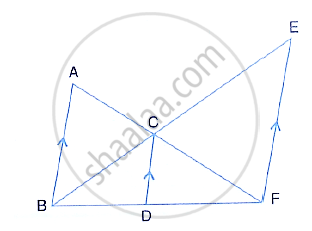
The dimensions of the model of a multistoreyed building are 1 m by 60 cm by 1.20 m. If the scale factor is 1 : 50, find the actual dimensions of the building.
Also, find:
- the floor area of a room of the building, if the floor area of the corresponding room in the model is 50 sq. cm.
- the space (volume) inside a room of the model, if the space inside the corresponding room of the building is 90 m3.
The following figure shows a triangle ABC in which AD and BE are perpendiculars to BC and AC respectively.
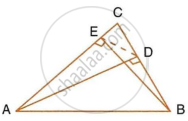
Show that:
- ΔADC ∼ ΔBEC
- CA × CE = CB × CD
- ΔABC ~ ΔDEC
- CD × AB = CA × DE
In the given figure, ABC is a right angled triangle with ∠BAC = 90°.
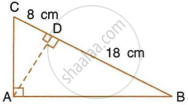
- Prove that : ΔADB ∼ ΔCDA.
- If BD = 18 cm and CD = 8 cm, find AD.
- Find the ratio of the area of ΔADB is to area of ΔCDA.
